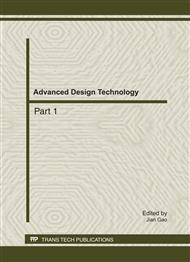p.1600
p.1604
p.1609
p.1614
p.1619
p.1627
p.1636
p.1641
p.1646
A Method to Obtain the Position of Space Object Based on Monocular Vision and Laser Ring
Abstract:
When the cylindrical laser shines on the target object, a spot can be obtained, which the edge is a closed curve, marked as C1. The imaging of the curve C1 on the image surface of CCD is a closed curve C2 too. Coordinate system is established to describe the position relationship among camera, image and light source, and to analyze the principle for monocular vision and laser ring to get the information about the object depth. In order to solve the problem and make the above principle clear, the key is to work out the expression for the curve C2 on the image surface of CCD. In order to calculate the closed curve C2 expression, the curve C2 will firstly be divided into two parts, the upper curve and the lower one. According to least-square polynomial, discrete points on the curves of two parts are drawn out, constraints are established and the curve equations are fitted. Then, to verify practicality of this method, a virtual model scene will be created, through which relevant data describing edge of virtual CCD image and that of a virtual spot when the virtual light source alights on the virtual object will be obtained. At last, closed curve equation will be fitted in accordance with data describing edge of virtual image; the position of space object will be fixed by making use of light source equation and closed curve equation; and a contrast will be made between the calculated value and data of the spot edge to prove whether a method to obtain the position of space objects based on monocular vision and laser ring is feasible.
Info:
Periodical:
Pages:
1619-1626
Citation:
Online since:
August 2011
Authors:
Keywords:
Price:
Сopyright:
© 2011 Trans Tech Publications Ltd. All Rights Reserved
Share:
Citation:


